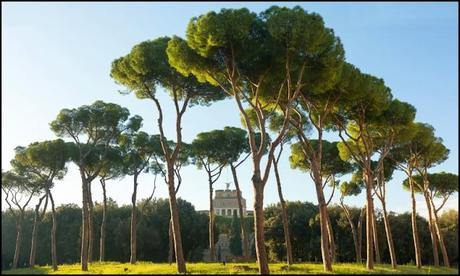The stone pine (botanical name pinus pinea ) has been cultivated around the Mediterranean for at least six millennia and was introduced to Italy by the Greeks. As well as looking beautiful and providing much-needed shade, it is also the source of the pine nuts (pignoli ) used to make pesto and to garnish Italian salads, and according to Livy (writing at the tail-end of BC), the wood was used for ship-building, 'pinea ' thereby becoming an alternative word for ship. A stone pine has a lifespan of between 50 and 150 years, so the task of maintaining and replanting a population over many centuries is a significant civic undertaking. Quite why it became so popular in Rome (now synonymous with and a recognised symbol of the capital), is not well documented, but the love affair is a deep and enduring one and these beautiful and striking trees have long been an integral part of the landscape and spirit of the place.

Rome's famous 'umbrella' trees
It was assumed until a few years ago that stone pines would forever decorate the city's streets and parks, but recently Romans have begun to fret. The very pressing cause for concern is a parasitic insect, the pine tortoise scale (toumeyella parvicornis ), which was introduced accidentally into Italy in 2014 via a consignment of timber from the USA and has been spreading steadily northwards from Naples, decimating the pinewoods of Campania and Lazio until arriving in Rome five years later.Diseases of trees are nothing new. We've become accustomed to losing large numbers of trees to Dutch Elm disease, Ash dieback, Horse Chestnut canker and Plane wilt. The more connected the world becomes, the easier and quicker it is for contagions to spread (as we found with Covid-19). In fact the poor stone pine is suffering from another affliction as well, an earlier parasitic visitor from the USA, the western conifer seed bug (leptoglossus occidentalis ) which arrived in the 1990s and feeds on the sap of the developing pine cones, threatening not only Italy's pine nut industry but also the tree's ability to propagate itself.
Worrying though the advance of the conifer seed bug is, attention is now focussed on the threat being posed by the tortoise scale bug to Rome's famous 'umbrella' trees, for the voracious parasite is quite capable of killing off a stone pine in two or three years. Many of Rome's trees are suffering from the pest. An initial large-scale felling of infected trees caused an uproar and so a fund was set up to inoculate stone pines in the hope of stemming the parasite's advance, for the city would be robbed of much character if the trees all die off.

an integral part of the landscape
There was much cynical party political point scoring at the outset of the campaign to save the trees, but the president has allocated €500,000 to the project that seeks to inject the trunks of trees with a treatment to fight the scabrous parasite and thus preserve "this natural and cultural part of the city's heritage."Although mobilisation in this war between new world fauna and old world flora was hampered by the arrival of Covid, the associated lockdown, and what some see as typical Italian inefficiency, the fight to save the stone pines is well under way now. And as a back-up, operation Ossigeno (oxygen) is creating nurseries of thousands of new trees should the worst happen. Let us hope that Romans are not left pining for their loss.
I've written a few poems that take playful liberties with time and history (introducing cigars into ancient Greece, early radar into Roman Britain, making valentine cards available to stone-age Romeos et cetera ) and I've done it again with this latest from the imaginarium, ostensibly about planting trees in renaissance Italy. Enjoy.
He's no intention of spending this week-endup a scaffold on his back thanks all the same,on a better offer from his pal Sagnallo. Tonylent him a hand to renovate the workshop so now's time to return the favour helping plant five hundred stone pine saplings for a Count.
Villa d'Este promises fresh air, a decent bedand maybe the chance to rekindle his affairwith the flame-haired servant in the segreto.Happy memories. If lucky, he could pick upa commission. Another statue on the bookswould see him comfortably through summer
and the Sistine Chapel isn't going anywhere.Raffa swills down a slice of greasy pizza, throws some clothes in a bag, lights a spliff,climbs into his trusty marbled Cinquecentoand roars away into Rome's petrol dusk. If he steps on it he'll make Tivoli by midnight.

beautiful and striking stone pines
I intend to plant a tree in my re-vamped Blackpool back garden next spring. It won't be anything as stunning as a stone pine. That would be too big and would look strangely out of place on its own. A fig or an olive tree is more likely, and if the climate in the jewel of the north remains mild over the next few years, I look forward to it prospering. I shall certainly take a leaf out of the new King's book and talk to it.Thanks for reading, S ;-) Email ThisBlogThis!Share to TwitterShare to Facebook